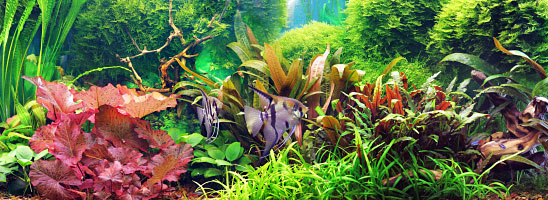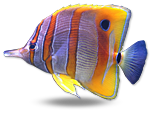
Aquarium Lighting Guide Introduction
The most important factor to consider before purchasing aquarium lighting is the requirements of the inhabitants you plan on keeping in your aquarium.
Aquarium lighting is the most important component for supporting photosynthetic invertebrates or plants. Make sure that the lighting system you purchase will provide adequate light intensity as well as spectrum of light to meet the needs of your tank's inhabitants.
Basic Aquarium Lighting System Components
Almost all lighting systems are comprised of the same basic components: a lamp, ballast, reflector, socket, and electrical wiring to connect it all together. A high quality reflector will considerably increase the amount of light that your tank receives.
Other additional components may include:
- Glass or Plexiglass Splash Shield - A must for metal halide lighting. Metal halides get extremely hot and one drop of water could cause the bulb to explode. A tempered glass splash shield will also help to filter out UV rays as well, usually required when using HQI metal halide bulbs.
- Waterproof End Caps - Used for protecting fluorescent bulbs from corrosion and salt creep when no splash shield is present.
- Dimmer Switch - Allows the lumen output of the bulb to be regulated.
- Hood or Canopy - An enclosure used to contain the lighting components.
- Cooling Fans - Metal halides and VHO fluorescents usually require some way to ventilate the build up of hot air, otherwise tank temperatures could rise.
Spectrum
In order to begin to understand the available spectrums of bulbs, we must first analyze how light naturally penetrates water. Red light is the first to be filtered out and can only penetrate a short distance. As light waves penetrate deeper into the water, orange and yellow are lost next. Of all the colors of the spectrum blue light penetrates the deepest.
Light spectrum is measured by the Kelvin scale. Natural sunlight on a clear day registers at 5500 Kelvin degrees. Kelvin temperatures less than 5500 become more red and yellow and the higher the Kelvin temperature the more blue the light is. Photosynthetic invertebrates should be kept under lamps rated at or near the Kelvin temperature where the invertebrate was collected. Shallow water species should be kept under 10000K lamps while deep water species would prefer 20000K lighting. Longer photoperiods can not compensate for incorrect light spectrum or intensity.
Actinic lighting peaks in the 420 nanometer range and emits a fluorescent blue light and is usually used as supplemental lighting. Not only is actinic lighting beneficial to photosynthetic invertebrates, it is also aesthetically pleasing to the eye when used to supplement "daylight" lighting.
Freshwater aquarium plants benefit from lighting with a Kelvin temperature in the range of 5500 - 6500 degrees. Freshwater plants prefer light with more red and yellow in the spectrum.
Timers and Controllers
All aquarium lighting should be on a timer to regulate the light schedule. The life cycle of your fish and corals revolve around your lighting schedule. The photoperiod of your aquarium should not exceed 12 - 14 hours of light per day.
For most aquarists, a simple, inexpensive 15 amp timer found at any hardware store will suffice for controlling the length of the photoperiod. Aquarium light controllers on the other hand will replicate the natural sunrise and sunset of the day by slowly dimming the lights on in the morning and off in the evening.
Fish-Only Aquariums
Saltwater and freshwater fish-only aquariums do not require very intense lighting. Intense lighting will cause excessive algae growth and shy many fish from coming out in the open. The basic normal output lighting that comes standard with most aquariums will most likely be plenty of light for your fish-only aquarium.
Natural Sunlight
Most people would agree that natural sunlight is the optimum type of lighting to support any photosynthetic plants or invertebrates. There are problems with using skylights and windows because they can not always be positioned to receive 10 -12 hours of direct, intense sunlight everyday. Another problem with using natural sunlight is that quite a few places in the world do not receive adequate sunlight in the winter. Cloudy or rainy weather could also reduce the available hours of light as well. Some have reported success using natural sunlight in conjunction with fluorescent or compact fluorescent supplemental lighting.
Aquarium Lighting Directory

